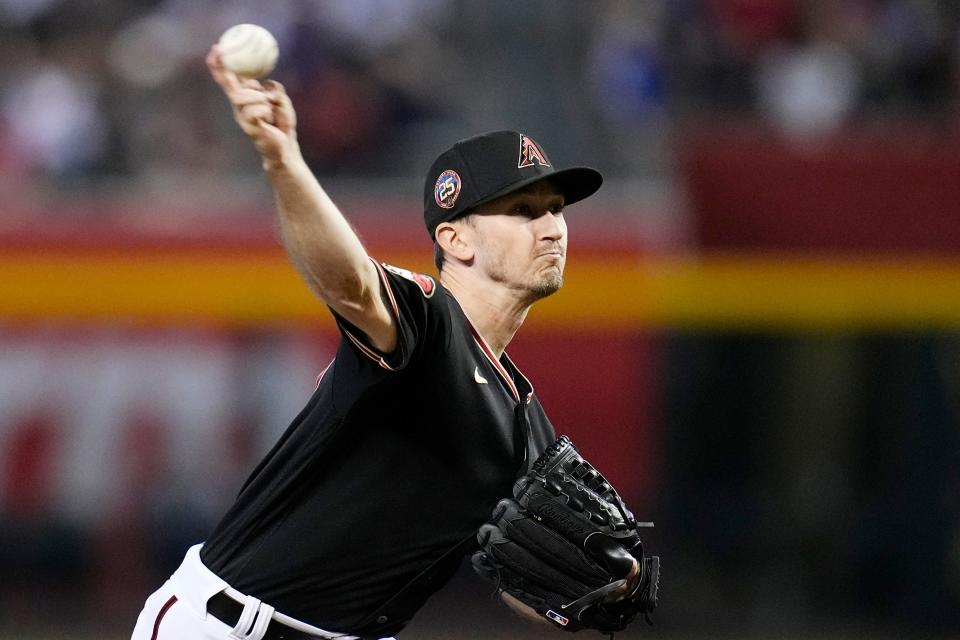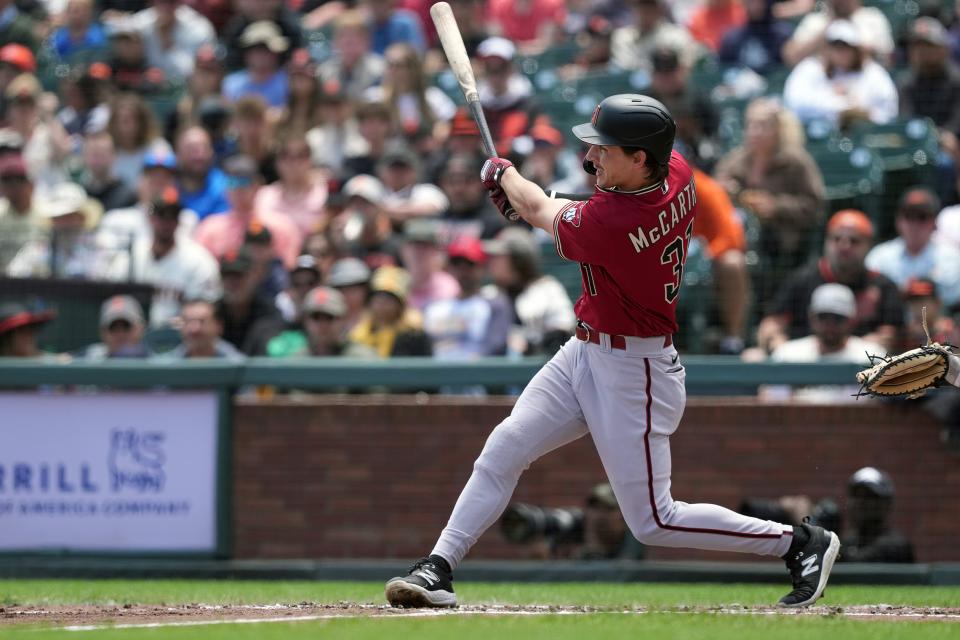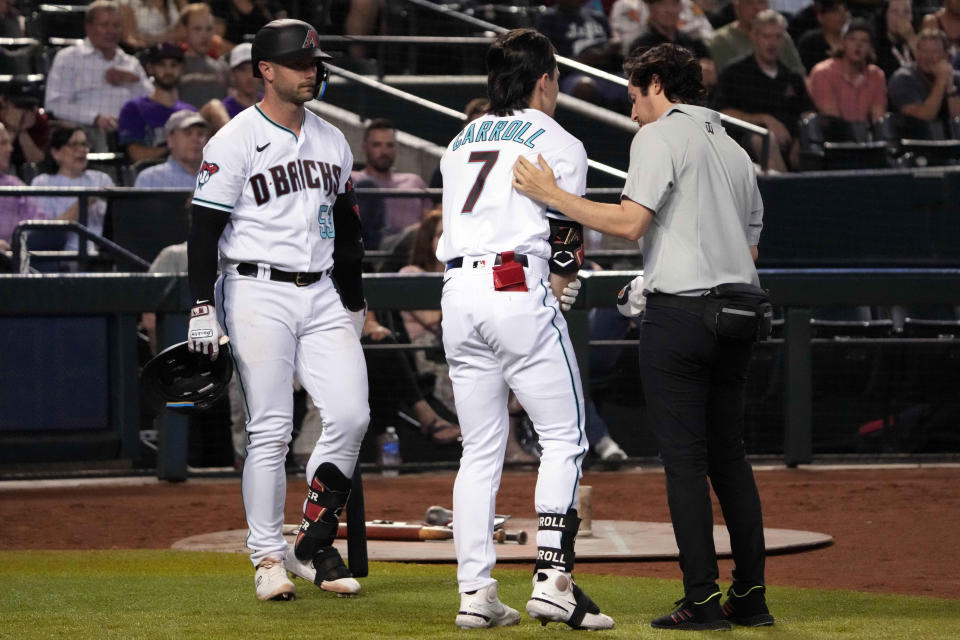Questions facing Arizona Diamondbacks as they try to build on first-half success
The month of July has not been kind to the Diamondbacks. Since the calendar turned, their playoff odds have dropped by 15% and their three-game division lead has evaporated. A 4-7 record stretching back to the final days of June has tempered the rampant optimism established in the season’s first three months.
And yet, consider where the Diamondbacks are. At the All-Star break, they are 52-39, in a virtual tie with the Dodgers atop the NL West. They’ve won as many games as they did in the entire 2021 season. Their playoff odds have climbed from 15.3% on Opening Day to 64.2% — a jump only bested by Baltimore and Miami.
Back in late March, the Diamondbacks would have signed on for this start without hesitation. The issue now is whether they can turn it into their first playoff berth since 2017. These are the questions that will determine that answer.
Can back end of Diamondbacks rotation be better?
Zac Gallen and Merrill Kelly have been two of the better pitchers in the National League. Beyond them, the Diamondbacks have gotten a 5.78 ERA in 55 starts from their rotation, with an average outing length of just under five innings.
Those numbers are slightly bloated by 10 mostly awful starts from Brandon Pfaadt and Madison Bumgarner, but Zach Davies’ 6.37 ERA and Ryne Nelson’s 5.19 ERA are still cause for concern.
That said, recent weeks have provided positive signs. After three terrible starts in a row following his return from the injured list, Davies has allowed seven earned runs in 18 innings over his last three starts. That’s not lighting the world on fire, but it’s exactly what Davies was signed to provide: stability.

Nelson was hit hard in his last start, but had a 3.10 ERA in the month prior. That coincided with work Nelson did on his mechanics with pitching coach Brent Strom. Since the change, he’s getting opposing batters to whiff on 23.4% of swings, up from 18.3% beforehand, which had been his biggest weakness.
Tommy Henry, meanwhile, has cobbled together a 3.75 ERA on the season. Various expected ERA metrics based on strikeout and walk rates peg Henry as one of the luckiest starters in baseball, but his ERA of 1.48 since mid-June remains impressive nonetheless.
Given all of those improvements, Davies, Nelson and Henry have actually been better than Gallen and Kelly since the last week of June. If their growth can continue after the All-Star break, it would provide a major boon to the Diamondbacks’ chances.
Will Diamondbacks add an arm at trade deadline?
Of course, the Diamondbacks could lessen their dependence on three potentially unreliable starters by making a trade deadline acquisition to bolster the rotation.
Ultimately, any move will come down to two factors: What the Diamondbacks are willing to pay and what the market price is for starting pitching.
The Diamondbacks could approach the Aug. 1 trade deadline in two ways. They could see themselves as a first-place team ready to make a deep run, or they could look at their young talent and be unwilling to mortgage the future to win now.
Moore: Carroll's first All-Star appearance is a reminder to stay in the moment
The price for starters, meanwhile, might be steep. Only a handful of teams currently look likely to be sellers, in part due to the expanded playoffs. Detroit’s Eduardo Rodriguez, the White Sox’s Lucas Giolito and St. Louis’ Jordan Montgomery headline the current market. A lot more than three teams, though, could use a starter.
The Diamondbacks could also stand to add bullpen help, which would come at a cheaper price. But over the past two months, they rank seventh in baseball with a 3.43 bullpen ERA. An addition there would have considerably less impact than in the rotation.
Can Diamondbacks' young hitters provide more?
If someone had told you in March that the Diamondbacks would send Jake McCarthy, Alek Thomas and Josh Rojas to Triple-A Reno before the All-Star break, it would have seemed more likely that they would be in last place than first.
So far, though, they have weathered underperformance from three key, young offensive pieces. Over the last month, Gabriel Moreno has joined that group with an extended slump. In 747 combined at-bats, those four players are hitting .244 with a .635 OPS — roughly 20% below league average.

It hasn’t all been bad from the Diamondbacks’ burgeoning young core. Corbin Carroll has been incredible and Geraldo Perdomo made the All-Star Game after being among the worst hitters in baseball last year.
But considering the performances of their veterans — namely Ketel Marte, Lourdes Gurriel Jr. and Christian Walker — imagine a Diamondbacks’ offense with all their young hitters living up to expectations.
Like with the rotation, there have been some positive signs of late. Thomas is hitting .328 with a .908 OPS since returning from Reno and McCarthy .300 with a .782 OPS. Perhaps Rojas and Moreno can show similar growth, although Rojas is currently on Reno’s injured list with a back injury.
Given the recent struggles of Emmanuel Rivera at third base and Carson Kelly at catcher, getting Rojas and Moreno right at the plate would provide a significant boost to the offense.
Have Diamondbacks been lucky, and does that need to continue?
All of the above points are directed at the Diamondbacks improving over the second half. Thing is, they don’t necessarily need to improve. If they continue at their current pace, they’ll finish 93-69 and almost certainly reach the playoffs.
There’s a possibility, though, that they’ve been lucky to go 52-39 thus far. Based on run differential, their record should be 48-43, according to Baseball Reference’s calculations.
That’s not all. They’ve also missed the least projected WAR to the injured list, per Baseball Prospectus. Perhaps that’s a result of a young roster bereft of injury-prone players. And maybe the Diamondbacks’ training staff, which kept them relatively healthy last season, is excelling. But it’s also possible that they’ve just won the injury lottery for three months.

Meanwhile, the Diamondbacks’ batted ball data — based on Baseball Savant’s calculations — indicates they’ve been among the luckiest offenses in the league. As a team, they have the third largest difference between batting average and expected batting average, and the largest difference between slugging and expected slugging.
Those types of calculations can vary — at least one team’s internal metrics suggest the Diamondbacks have been average from a batted ball luck perspective — but the last two weeks could be a warning sign. In that stretch, the Diamondbacks’ luck has reverted, with Baseball Savant pegging them as the second unluckiest offense in the National League. That coincides with their 4-7 record entering the break.
This article originally appeared on Arizona Republic: How the Diamondbacks can turn first-half success into MLB playoff spot

